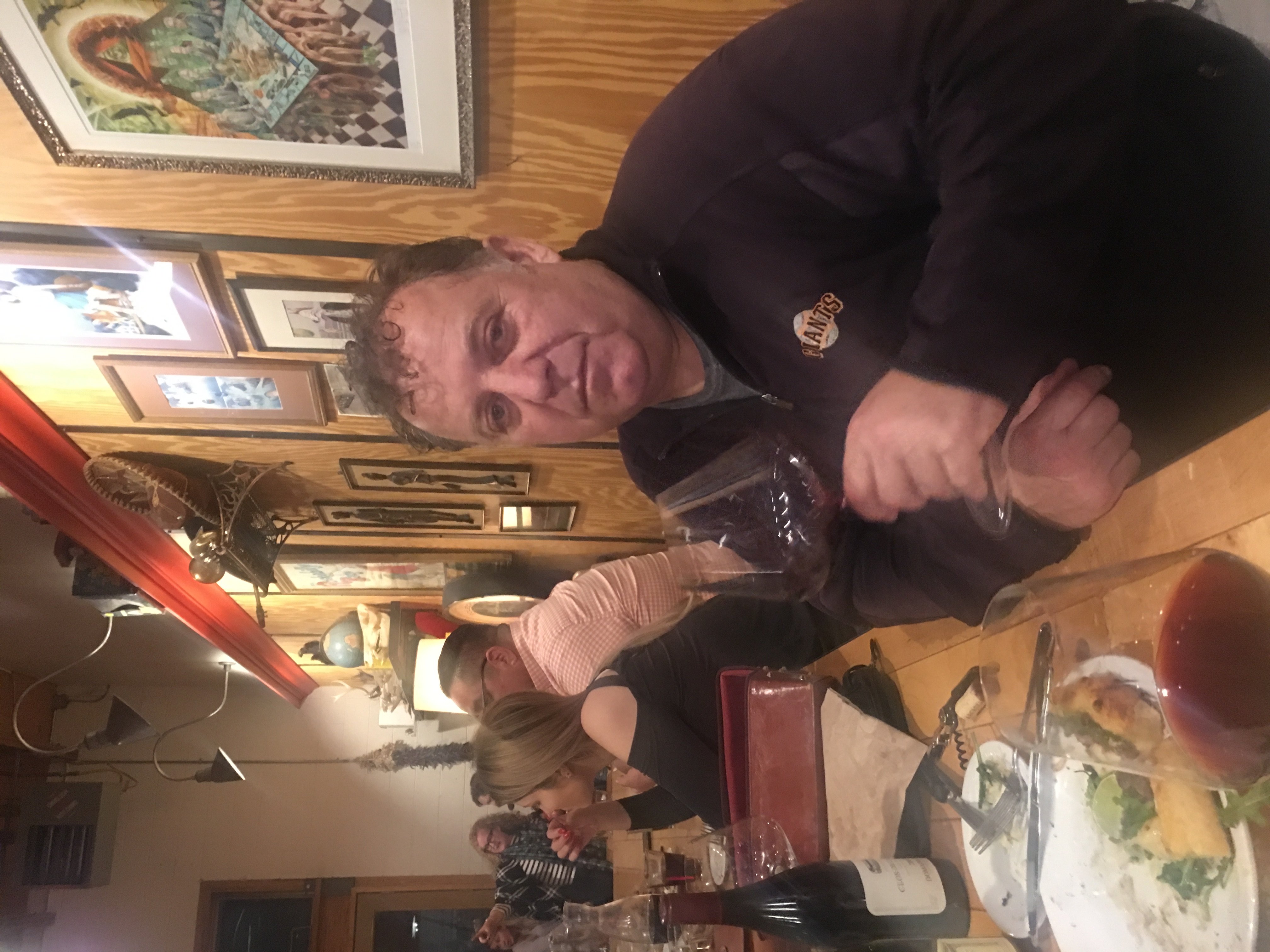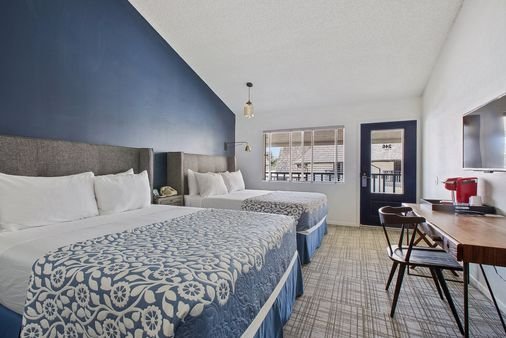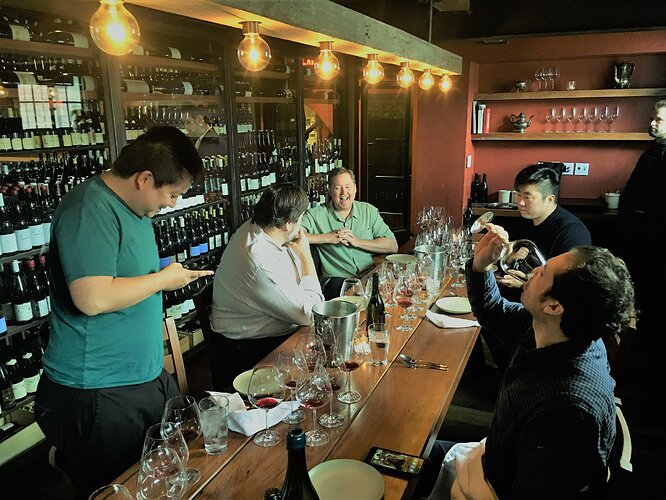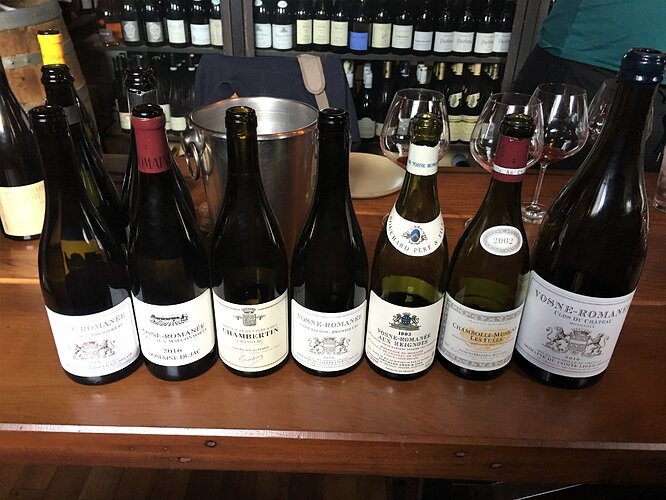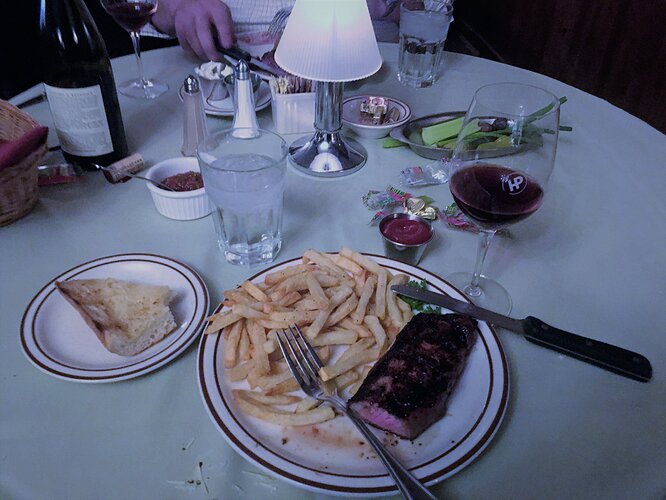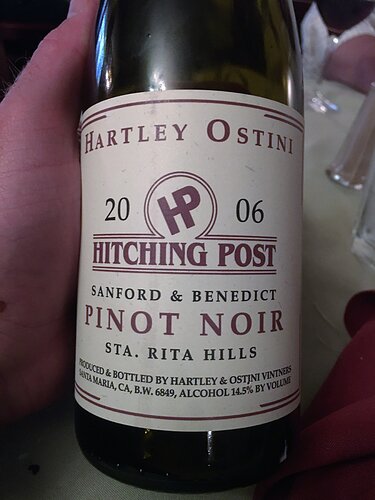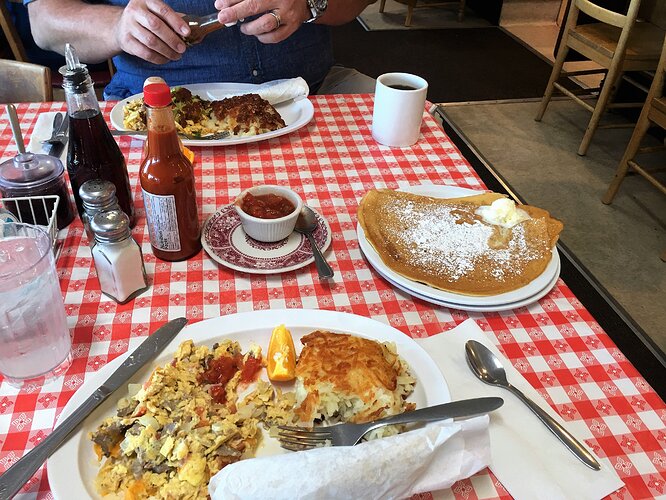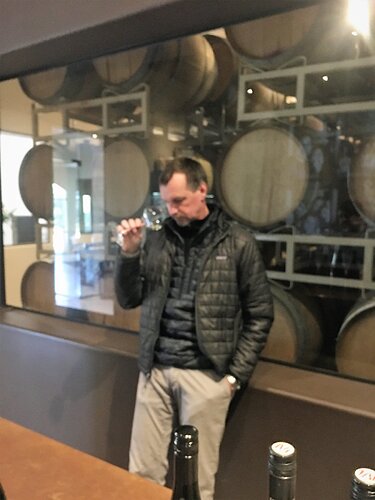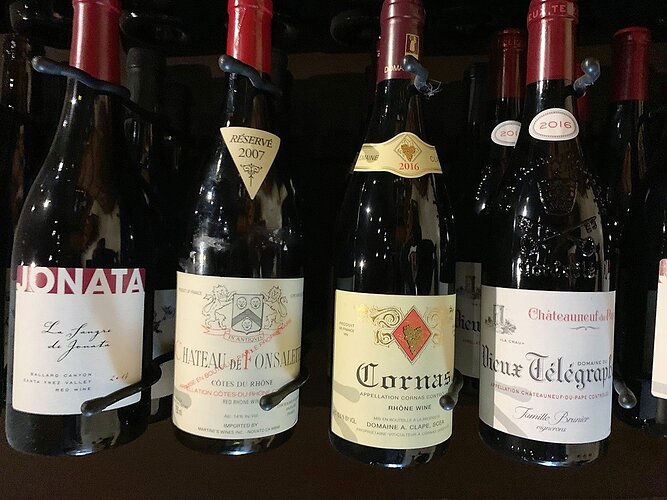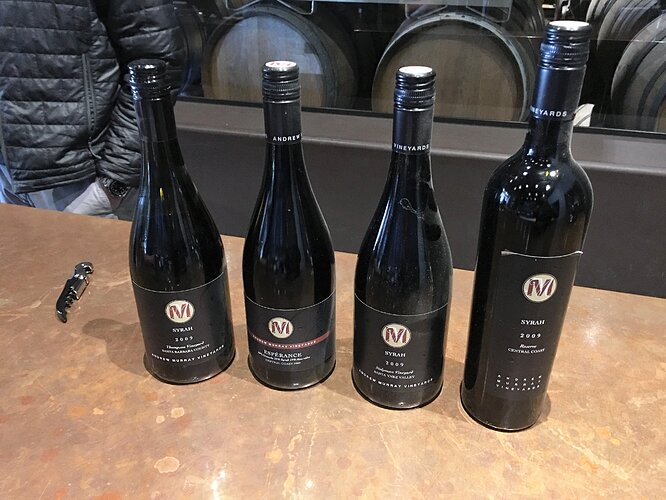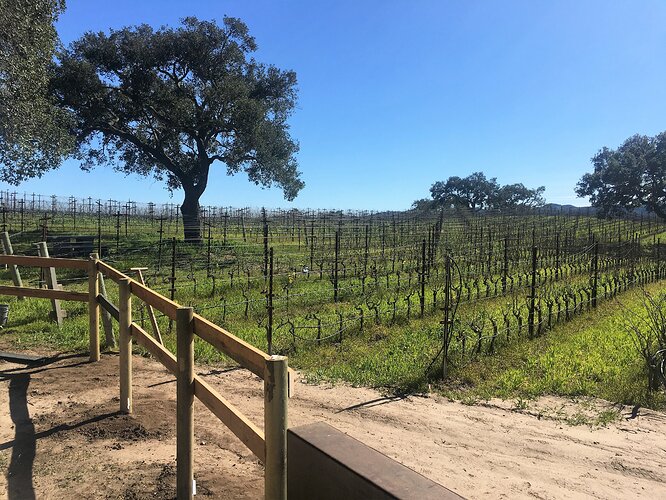And our story comes to an end …
Our next stop was the Arcadian tasting room, about a half-hour west of Foxen Canyon. Many smaller wineries have set up small production and tasting facilities in a non-descript industrial park at the edge of town lovingly dubbed in the Wine Ghetto.
After the picturesque rolling hills of Santa Ynez Valley, this cluster of corrugated steel boxes didn’t really entice. A steadily stiffening breeze blew across largely empty parking lots. A few patrons wandered on the blacktop in flat wintry light. I felt like I should be buying aftermarket car parts instead of boutique wines.
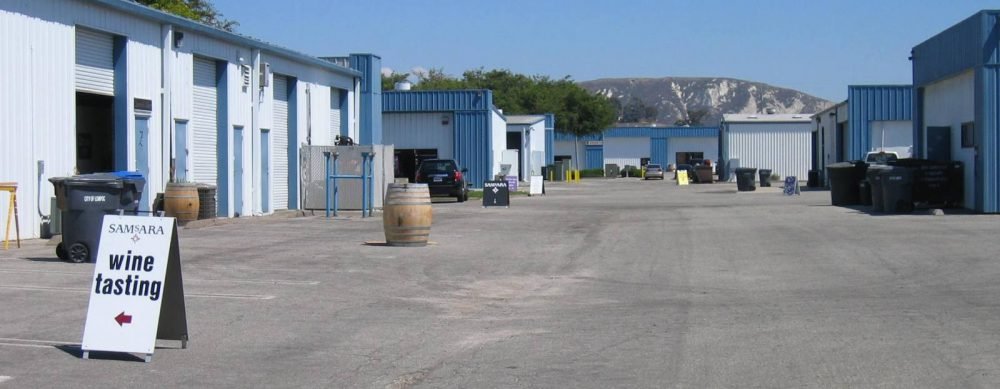
To be fair, this was late in the day during the slowest, coldest month of the year. I can imagine the area, which houses such Young Turks as Sandhi and Tyler, could be rocking with food trucks and crowds on a July weekend afternoon. Being able to easily hit a cluster of wineries with no hassle must be appealing.
After driving in circles a bit, we finally found the Arcadian facility. Beth, who has been Joe Davis’ left-and-right-hand woman for nearly a decade, welcomed us warmly into the cozy tasting room. Painted in yellow, the small space is littered with all kinds of treasures – half bottles, magnums, specialty releases going back 10 years or more. It’s also telling that the biggest wall adornments are maps of Burgundy’s Cote d’Or and Cote de Beaune. Good sign.
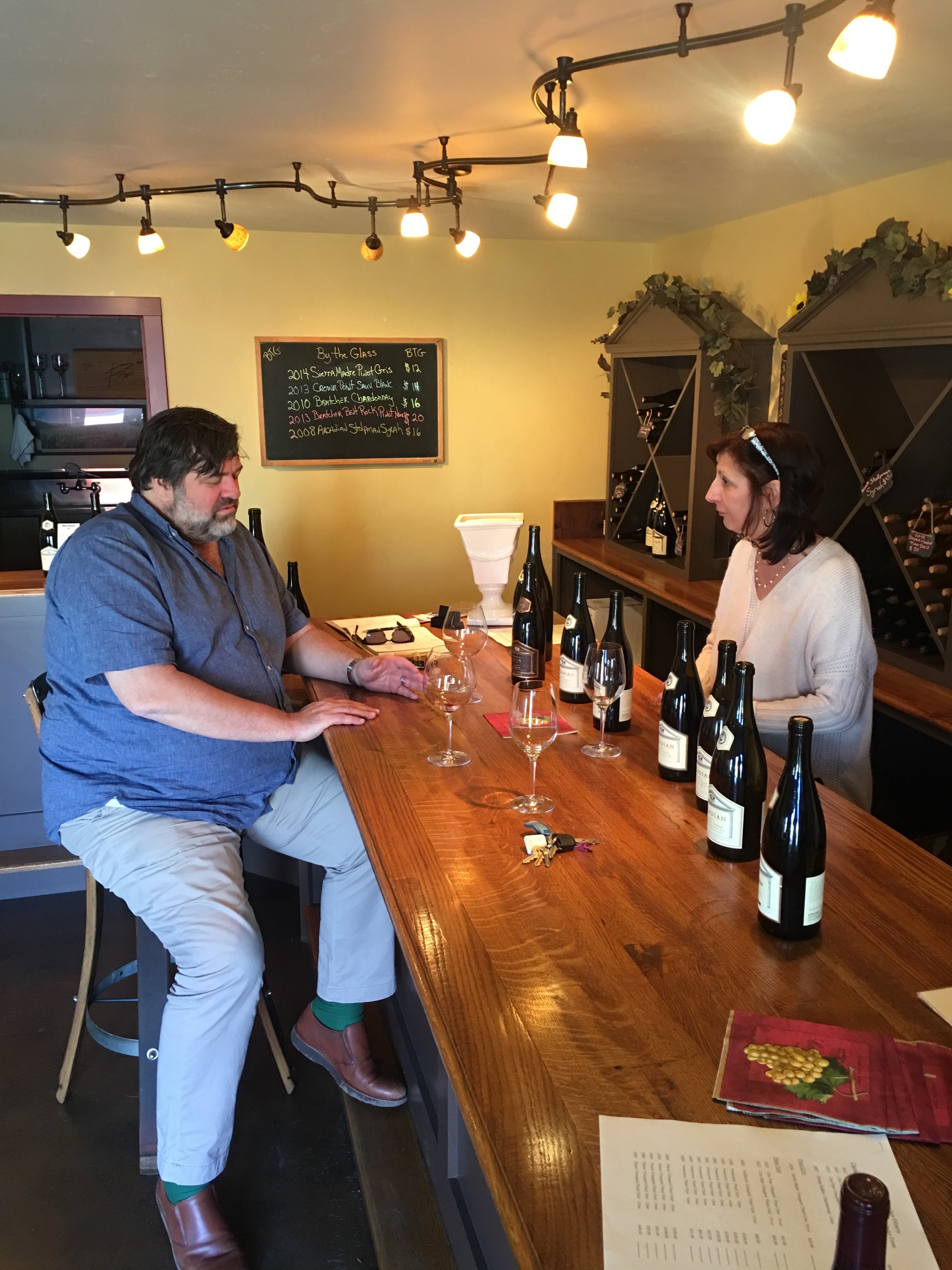
Joe had texted me earlier that he was on the road heading back from LAX, so he wouldn’t be able to join us for the tasting. But he kindly offered to meet Greg and me for dinner later that night at Industrial Eats in Buellton. He even promised to bring some library bottles from his home cellar. Score!
Joe is the eminence grise of Old World-style winemaking in the Valley. Joe, who studied enology at UC Davis and cut his teeth making wine at Morgan nearly 30 years, ago, is a definite terroir-ist. He works with some of California’s most distinctive vineyards – Sleepy Hollow in Monterey, Pisoni in Santa Lucia Highlands and Clos Pepe in Santa Rita Hills. He makes Chardonnay, Pinot and some Syrah, bottling about 5,000 cases a year.
His non-interventionist style calls for lots of cold soaking, minimum racking, whole cluster pressing, and some fermentation in barrel. He’s also fanatical about the wood his wines are raised in, sourcing oak from a very specific forest in France. (We’ll hear more about that at dinner!) Given that he connected with the Dujac crew in Burgundy back in the day, none of this protocol should come as a surprise.
Joe holds back wines for many years in bottle before release. It’s obviously not the most economical way of doing business, but the added time clearly benefits the final product. His wines hit the market about five years after vintage. The extra resting time allows his wine to show unusual restraint and complexity.
They stand out from their peer set in a region that produces a lot of forward, lusher wines – at least to my palate. There’s a savory quality that you typically don’t see in Santa Barbara-area wines – sous bois in the Pinots, a mushroomy/Parmesan rind note in the older Chardonnay. These are California wines for Burg lovers. (For example, at our Republique lunch, fellow Arcadian supporter Charlie Fu said that Joe’s 1999 Sleepy Hollow Chard is as close he’s seen a CA Chard come to Grand Cru White Burgundy.)
As to the tasting, Greg and I were like kids in a candy store. Beth basically opened up anything that interested us – some newer release Clos Pepe Pinot and Stolpman Syrah from 08. It was instructive to contrast Andrew’s Stolpman to Joe’s, which shows more structure and some stemmy and earthy notes vs. AMV’s fruity ebullience.
We also sampled some chards (06 and 08) from the Sleepy Hollow vineyard. These too seemed a bit tight on opening, with a lactic note and a steely Chablis-like quality. We also sampled a 2006 Hommage a Max Syrah, a mélange of Joe’s best lots in honor of his son. These are typically big wines with blackberry, loam, black pepper and a bit of saddle.
Pop-and-pour at the winery is NOT the best way to appreciate Joe’s wines. After snoozing for so long, they need more air and time to unfurl. For example, we took the two Chard bottles with us for our dinner later with Joe. With food and additional air, they opened up noticeably– becoming more golden and showing an intriguing mix of tart tropical fruit with that mushroomy note.
I told Beth I felt guilty about her opening up so many bottles that we had only had a few ounces from. She graciously offered to pack up a few bottles for the road, explaining that if Joe had been there that he would have opened up more bottles.
We agreed to meet Joe at Industrial Eats back in Buellton. Several Berserkers had recommended the restaurant to us. It’s exactly the type of high-quality, low-pretension place that any wine lover would crave in her/his city. A high-ceilinged spot with long communal table seating, IE offers a gastropub/cafeteria-style vibe in a repurposed warehouse. It’s seemingly always packed, filled with locals, foodie tourists and members of the working wine community.
The spot features about two dozen offerings scribbled on butcher paper on the wall. The menu changes weekly. You wait in line to place your order and then friendly, tattooed waitresses deliver your food to your table.
It’s farm-to-table California cuisine with a Santa Barbara ag vibe. They source super-fresh provisions from local ranchers, farmers and anglers who they count as friends. And here’s the best part: absolutely no corkage at any time! You just have to bring your own stems.
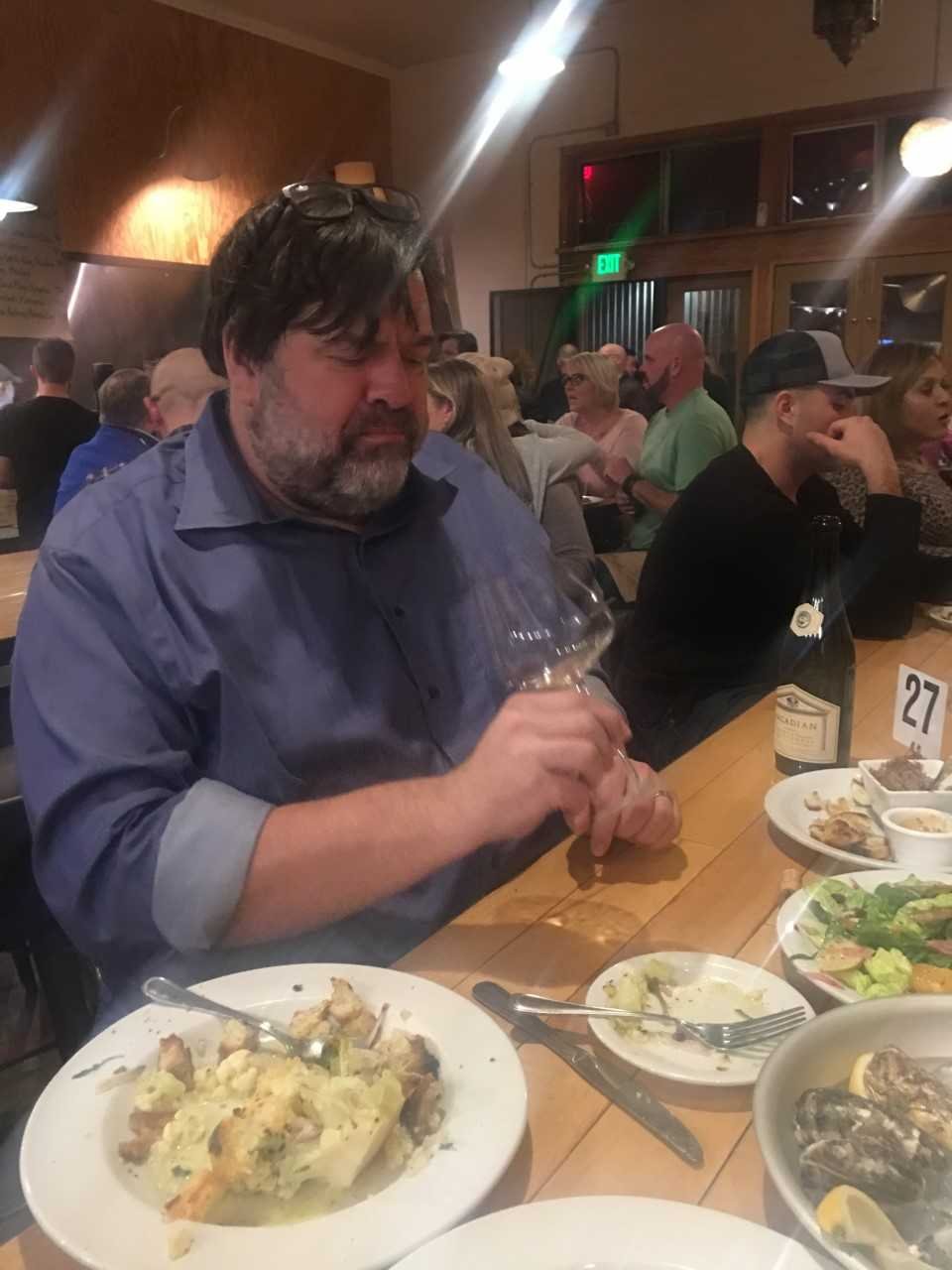
On the night we visited, we had platters of Baja oysters, carne asada pizza, porchetta with potato and pasilla, cauliflower in a light béchamel sauce, and gem salad with egg and pancetta. Every dish was spot on—bold flavors in balance, non-mannered presentation and a light touch that works well with wine. I can’t recommend this establishment more highly.
I offered Joe major props for rallying to meet us for dinner after hustling back from LAX after a few days on the road promoting his wines. Greg rewarded him with some 06 Dom that we had bought that day for the occasion. (If you ever want a sign of DP’s massive production and distribution capacity, just know that they are able to sell into a tiny Lompoc liquor store!)
Joe grew up in a family of fishermen in Monterey County. That hard-working upbringing is still readily apparent when you meet him. He’s super down-to-earth, friendly but you can tell he’s demanding of himself, his employees and interns, and of his wines.
With his beefy forearms, strong hands and stout, somewhat roly-poly build he looks a bit like a wrestling coach. He’s got dark, thinning curls and deep-set kind eyes. This night he wore a simple S.F. Giants fleece, a transgression this Dodger fan politely ignored.
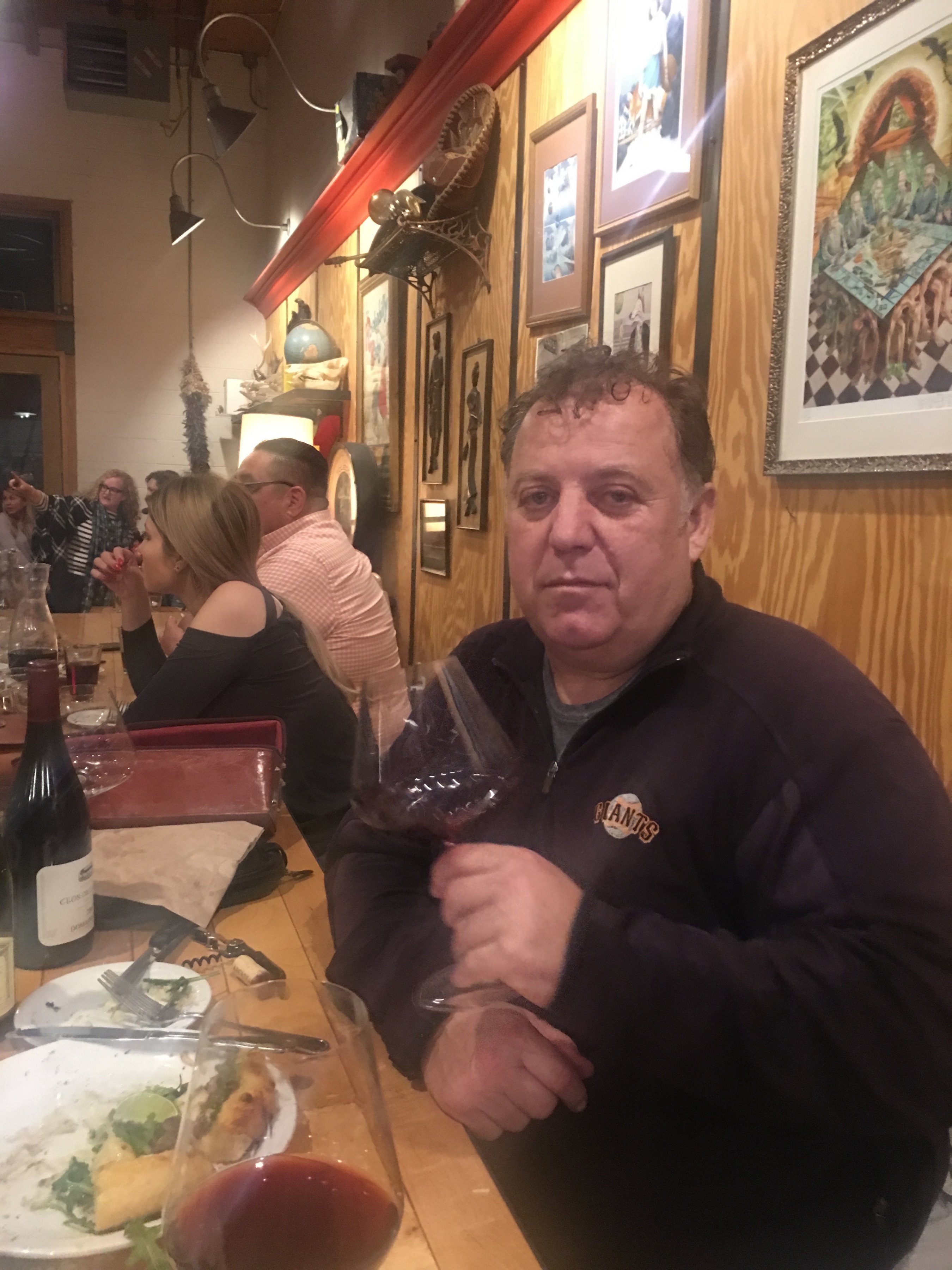
As we enjoyed our Champagne, Joe began to tell us his story. He’s been making wine for decades but is still passionate about his craft. He’s got a scientist-meets-poet vibe that has him mixing chemical terms with flights of fancy when describing why his wines taste the way they do. You get a sense he knows more than most of his SB winemaking peers, but he’s still got a lot to learn.
I asked him why his wines seem to have a longer aging curve than most SB wines. He did his best to dumb it down for this English major, emphasizing that it has to do with the amount of oxygen in his wines at bottling. He said most winemakers try to get their wines to market quickly, so there’s a lot of racking in the first two years of their life as they move from barrel to barrel to get off the lees and into bottle.
He said he allows his wine to sit in a cool place for extended periods, reducing the introduction of oxygen. I may get these numbers slightly off, but I think that he said his wine comes in under 2 parts of oxygen per million, as opposed to the 4-6 ppm of most other SB wines.
We also talked about some vintners choosing to gussy up their wines for market with more overt oak notes, often sourced from more showy wood. Joe takes his oak very seriously. Instead of buying finished barrels, he said he travels to a special forest in Burgundy, identifying specific stands of oak. He and his associate then buy them at a special auction dedicated to coopers.
It’s clear that Burgundy remains Joe’s touchstone. He told us about meeting Jacques Seysses of Dujac fame at a party in San Francisco when he was a young winemaker at Morgan. As he tells it, he had no idea who Jacques was at first sight, but when introduced the two fellow winemakers hit it off. Jacques wound up inviting him back to Morey St. Denis to work a harvest and help make wines. His early attachment to Dujac no doubt informs his rich, spicy, stemmy, age-worthy style to this day.
Hoping to wander down memory lane, I had brought an 07 Dujac Clos de la Roche to share with Joe over dinner. I figured its breeding and the early-nature of the vintage would reveal a classy, open wine. But it never really came out of its shell, which was a shame. I think it might have been slightly corked, given the muted aromatics and flat palate.
Joe seemed polite about the Dujac. But in reality his 02 Pisoni Pinot outshone the Burgundy easily. In fact, the Pisoni was Greg and my consensus wine of the trip. I’m not sure if it was the environment or Joe’s magnetic presence, but the red-fruited wine really shone: raspberry, soil, herbs and bright acids that gave the 17-year-old wine plenty of lift.
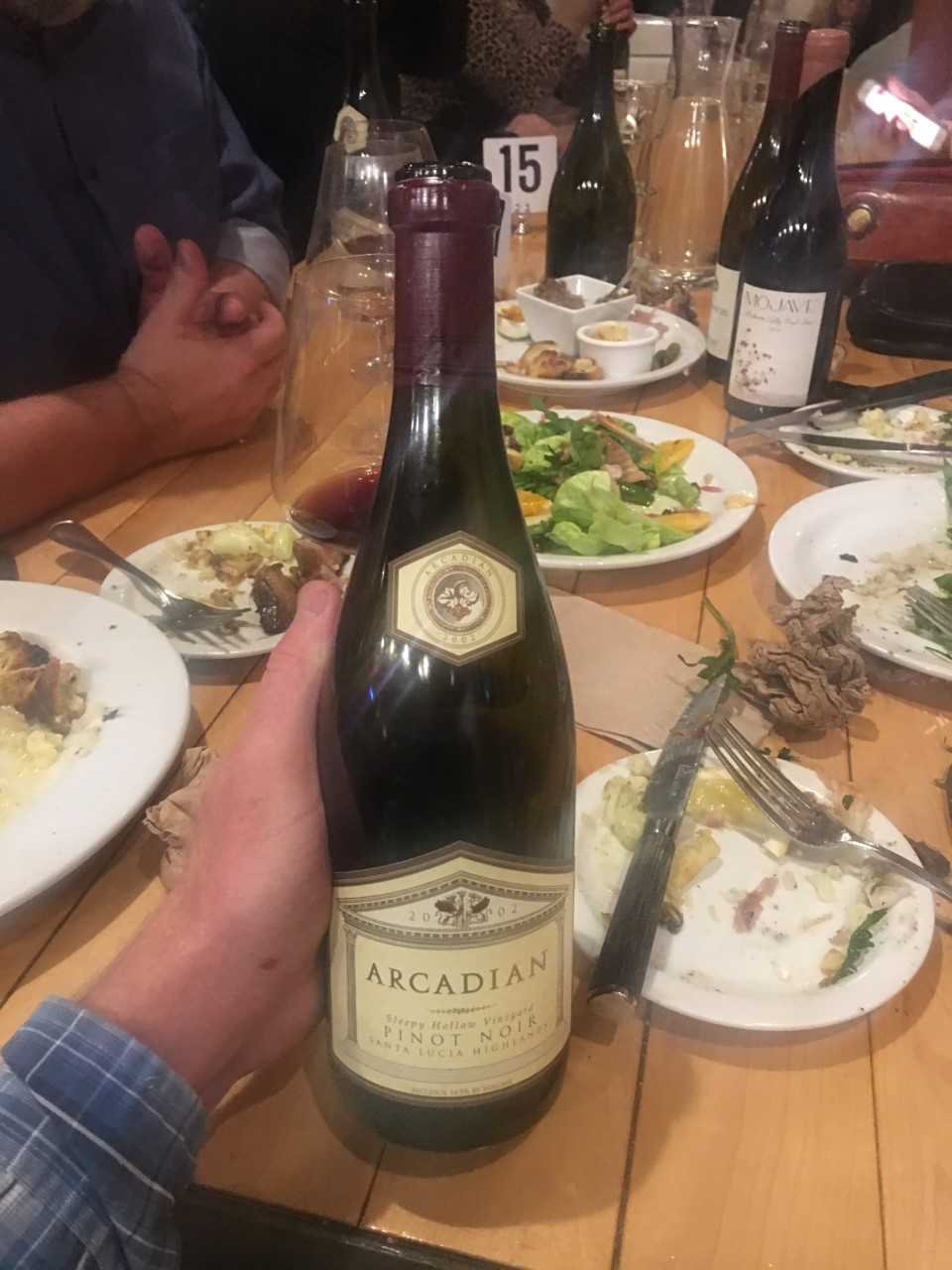
The bottle didn’t seem like typical Pisoni to me. I asked him how the wine managed such freshness and low-octane appeal from a vineyard known for such powerful, over-the-top wines. He said it really boils down to picking time, saying he harvests his grapes at the fabled plot much, much earlier than his fellow winemakers.
In the Small World Department: Joe told us he had a girlfriend during his time in Burgundy named Virginie Taupenot. She now helps her brother Roman run the steadily improving Taupenot Merme domaine in Morey St Denis. If you’ve read my previous travelogue from Burgundy, you may remember Greg and I had an initially very awkward tasting with Roman a few years back. It was the gracious Virginie who helped smooth things over and get us settled.
Joe has a strong take on this kind of Trans-Atlantic mentoring. He says he gets dozens of requests from aspiring winemakers eager to refine their craft by interning at Arcadian. He says many of these aspirants come from overseas wineries, often more interested in checking off the box of having worked abroad than really rolling up their sleeves.
Joe says he rejects most applicants because they don’t seem eager to work as hard as he does. He admits he pushes them but never asks them to do manual labor that he isn’t willing to do himself.
He says he’s willing to tell interns all that he knows about the craft of making wine so long as they work their ass off. Those who do make the cut are like those brave souls who toil away at a Michelin sushi restaurant, cooking rice for years before touching fish or sharpening a knife. Joe says he is proud of those who graduate from his system, such as Justin Willett of Tyler Winery.
One other anecdote that I loved: It’s apparent that the Sleepy Hollow Vineyard is Joe’s first love and main squeeze. He’s been making wines from the spot for a long time. He told us the name comes from the fact that the initial owner of the vineyard hailed from the Hudson Valley area in New York. (Maybe it’s Jerry McFarland?) Apparently, in the late ‘60s-early ‘70s, he had driven his van across the country way out to rural Monterey County and basically squatted on what is now the 400-acre Sleepy Hollow vineyard. The rancher-owner bumped into him and said he’d have to move on. Instead, the vagabond offered to buy the property for a princely sum of $400! He’d later sell to Talbott, I assume, at a very fat profit.
As our dinner came to a close, two great things happened.
First, the owner of Industrial Eats, Jeff Olsson, stopped by to say hello and try some wines. He brought over some Epoisses cheese to go with the Dujac and Pisoni, which worked out perfectly. Jeff is a completely down-to-earth non-foodie foodie – if that makes sense. It’s clear he has a deep simpatico with the local winemakers who practice their craft in the same area he does. He also offered us some cleansing ales on the house after hours, well after the last customer straggled home happy. He would’ve let us stay there as long as we wanted I imagine. Cool guy.
Second, we met this tiny, wacky local woman, a British ex-pat who had bought an equine facility and a few dozen acres in Santa Ynez Valley following her divorce in the U.K. She didn’t know anything about wine, but hit it off with Joe and us, offering her unvarnished critiques of the bottles on the table.
And in a total cool moment of serendipity, she mentioned that she focuses on cutting horses for riding. She then said knows people who train working horses. Joe lit up and said that indeed he’s looking for a dray horse to help him plow his fields in typical old-school way. I expect a deal any day.
With the lights being turned up, we thanked Joe profusely for his generosity after a long day of traveling and called our Uber.
I jokingly titled this post “Fear and Loathing in Buellton.” I wish I had more salacious stories to share, but alas there were no ether-fueled raves in vineyards or bedrooms. And unlike Miles and Jack in “Sideways,” there are no infidelities, broken noses or car accidents to report.
As wild as it got was Greg and I heading back to the bar at the Sideways Inn for even some more cleansing ales. (I can heartily recommend the Topa Topa IPA from nearby Ventura County.) It was fun flirting with the cute, happily married bartender, who said we seemed OK for guys heading up from L.A. She says that there has been some backlash against entertainment types from LaLa Land buying up ranch properties in the Valley. To her mind, these isolationist, snooty poseurs are driving up prices, worsening traffic and disrespecting local customs. A familiar tale …
We closed that place down as well. We returned back to our room at 2 a.m., where in our slightly compromised state we decided to mix the other half-drunk bottle of Joe’s chard with some OG Kush and “Jimmy Page and The Black Crowes at the Greek.” Oy vey!
We turned off the lights at 3 a.m. It had been a long, fun day. But we had to get up early to make it to Santa Anita racetrack for first post.
Let’s put it this way: After the day and night before, we didn’t make it to the track. I am proud that we did hustle back in time for the Dark Star Orchestra concert in Beverly Hills Saturday night.
But that’s a story for another time. And another message board!
